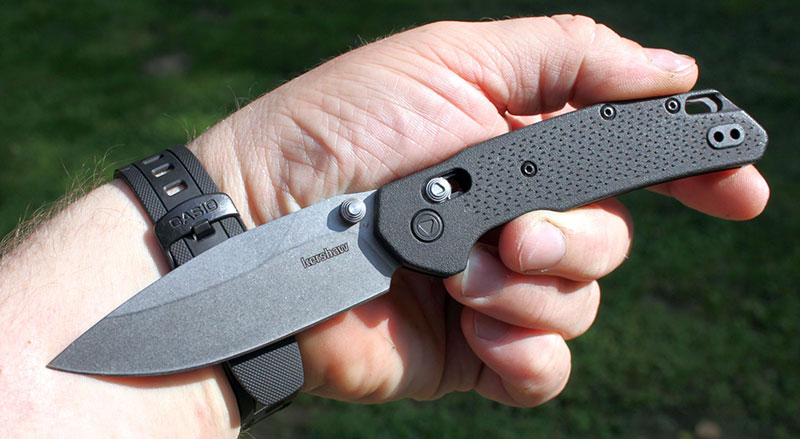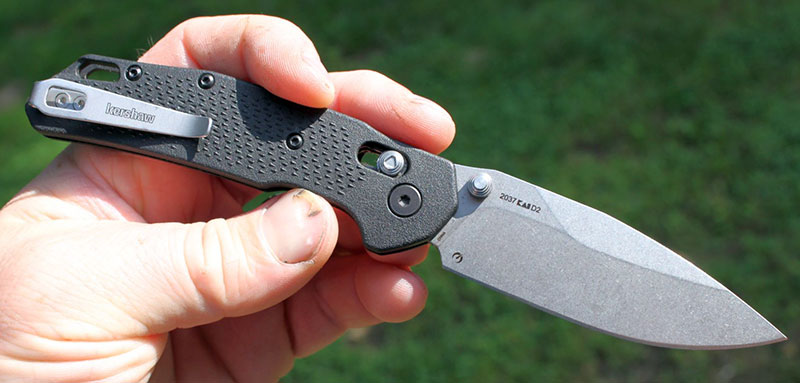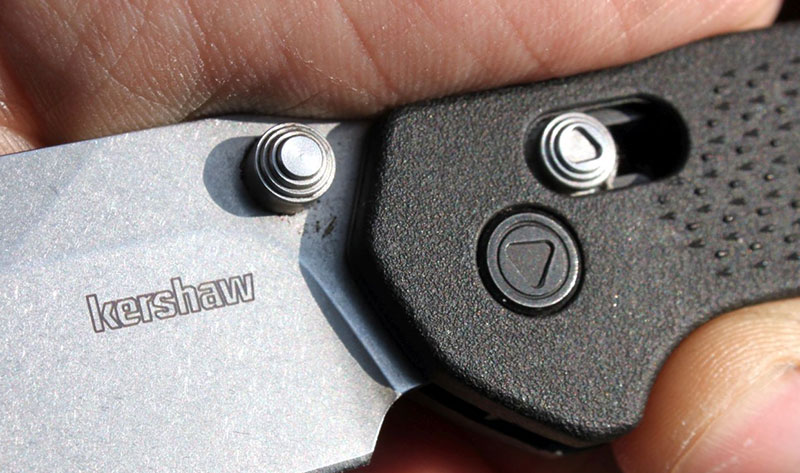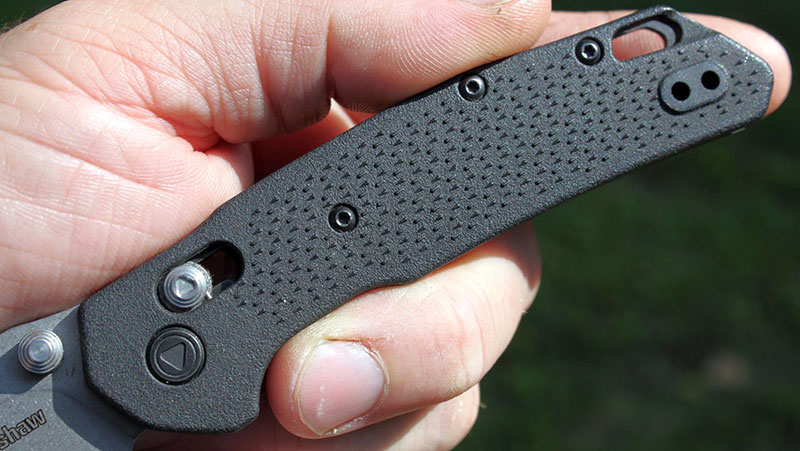We independently evaluate all recommended products and services. Any products or services put forward appear in no particular order. If you click on links we provide, we may receive compensation.

Kershaw Heist
Quality/Performance - 77%
Value for Money - 86%
82%
- Pros: Thin blade stock for slicey grind, slim construction, lightweight, no-flex handles, smooth action, solid ergonomics, great value for money
- Cons: The base of the pocket clip catches on the hem of your pocket going in.
According to dictionary.com, a Heist is either a noun – “a robbery or a holdup” – or a verb, “to take unlawfully, or to rob or hold up.” The implication is that something’s being stolen right out from under your nose. After carrying the Heist for a while, I think I may have figured out whose family heirlooms Kershaw is stealing out from under their nose, but we’ll get to that later.
First, some background: this is yet another sliding-bar lock knife from a company that didn’t previously dabble in them. While Kershaw is certainly not new to making folding knives (they’ve been in the business since 1974), only this past year have they introduced their first sliding-bar lock knives, or AXIS-style lock knives. As we’ve mentioned in previous reviews, including knives from Gerber, SOG, and Ritter/Hogue, after the functional patent on the AXIS lock expired, other manufacturers were able to integrate it into their knives, just not using the same name. Thus, we have the Kershaw DuraLock, another new name on a familiar concept – a spring-driven lock bar that slides in a channel over the top of the blade tang to hold it in place.
Key Specs: Kershaw Heist
Kershaw launched their line of DuraLock knives at the beginning of 2023 with the hugely popular Iridium, as well as this knife- the Heist – and two other knives we’ll be talking about more soon, the Covalent and Monitor. Right off the bat the Iridium became a viral sensation with a lot of videos from big YouTube channels praising its looks, construction and value for money. The Iridium is absolutely a cool knife, and hopefully we’ll check one out in the future (they’re sold out and not currently available anywhere) but the Heist seems to have been overlooked in the hype around the Iridium, and I think that’s a mistake.

The Heist was a knife that didn’t immediately impress me, but upon carrying it for a couple weeks I realize what an absolute masterstroke Kershaw have pulled off: if the Iridium is a budget version of a Benchmade Anthem, the Heist is a budget version of a Bugout. And in some ways, it’s preferable.
While the other three models feature KVT ball bearings, and the Covalent and Monitor use flippers for deployment, the Heist has phosphor bronze washers and thumb studs. So if it lacks the super-slick deployment of ball bearings, this allows the Heist to be very light and very thin, things that make it a better EDC in most ways that matter. It’s also inexpensive, coming in at $55 retail price ($68 MSRP) at time of writing. I ended up really liking the Heist, the first affordable Kershaw that’s blown me away since the Bareknuckle back in 2019. Let’s dive a little deeper into this budget hit.
The Blade
The Heist’s blade shape is a modified drop point, measuring at 3.10” inches long but with very thin 0.09” wide blade stock. The majority of folders around this size are sporting blade stock in the 0.12”-0.15” range, and while we spend a lot of time talking about grinds and shapes and bevel height, the biggest determinant of how well a blade is going to slice is how thin the stock is. 0.09” puts the Heist near slicing-specific designs like the ultrathin Spyderco Chaparral folder – and the same as the full-sized Bugout.

The shape of the blade is unconventional for sure. It’s a very broad drop point, measuring 1.05” from blade to spine at the widest point, so in addition to having super thin blade stock, it has a tall profile to create a narrower primary bevel angle. That primary bevel is a high flat grind, with a deep swedge along the spine to thin the blade out towards the tip. That spine has three separate surfaces, with a thumb ramp at the rear, a flat section in the middle and then a gradual turn down towards the tip – it’s strange looking, but it manages to make the blade thin where it benefits from it but thick enough to still be strong behind the tip. The finish is a medium stonewash, which is always my preference for a working knife since it hides scratches well.
Blade steel on the Heist as well as the other three DuraLock knives is standard D2 tool steel you know and love – high carbon, low chromium, the best-performing budget steel with some caveats. We’ve talked about D2 endlessly on this site, so suffice to say: it holds an edge very well for the price, isn’t the most corrosion-resistant steel (so care should be taken with what you cut and how you store it,) and it’s very tough. Making this blade out of D2 makes a lot of sense, because the high toughness of this tool steel cuts down on potential chipping of the edge due to how thin the blade is, and makes snapping the tip off harder too. For knives around $50, D2 is still my favorite steel – after all, if it’s good enough for a $500 Medford, it should be just fine in a $50 Kershaw – right?
Deployment & Lockup
The Heist uses thumb studs for deployment, with phosphor bronze washers in the pivot. This used to be the norm for budget knives, but in the last ten years or so even $50 knives have started coming with bearing pivots – including the other three DuraLock knives which use Kershaw’s KVT bearing setup. So rather than a cost-saving measure, using bronze washers on the Heist seems like a specific choice. Bronze washers do have their advantages – they’re self-polishing, meaning the more you use them the smoother they get. They’re not nearly as susceptible to dirt intrusion – there’s not really space for pocket lint or sand to get in between the washers and blade or liners like there is with bearings.

They’re also very thin, very light, and very durable – all things that can’t necessarily be said of bearings. The tradeoff is usually that bearings are much smoother both opening and closing than washers are. That’s true here – this knife would absolutely be smoother on bearings – but it doesn’t really matter. This knife is still very smooth, able to drop open or closed about 90 degrees when holding the knife horizontally and pulling the lock back just under the blade’s own weight.
In practice this means that you don’t need a wrist flick to open this knife via the studs, and you only need a tiny wrist flick to close it. Sliding-bar lock knives never have the greatest detent strength – since it’s derived from spring pressure and not from an actual detent ball, and having the spring pressure too high will make closing the knife annoying. But it’s dialed in just right on the Heist, requiring just a little thumb pressure upward and outward on the stud to get the blade to pop open. This knife reminded me that I do enjoy bronze washers, if for different reasons than bearings. You can also effectively wrist flick the knife open by holding the lock and flicking outwards, but this is hard on the lock bar and stop pin.

Lockup is solid, with no observable blade play horizontally or vertically. There is also no sticking or popping of the lockbar as you pull it back like a spring moving around on it’s perch. For the brand’s first attempt at a sliding bar lock, the DuraLock on the Heist is very well executed.
Features, Fit & Finish
The Heist is a $55 knife with GFN handles, but it is still well made. All the body screws are flush with the scales, the blade is perfectly centered when closed, and both the primary and edge grinds are clean and symmetrical.

Construction of the Heist consists of a pair of glass-filled nylon handles with a high-traction grippy texture pattern molded in on top of a pair of nested stainless liners. The liners are nested in the scales but aren’t skeletonized, which is odd considering the lightweight slim nature of the knife. Construction is bolt-through with hourglass standoffs and flow-through construction for easy cleaning, with three T6 Torx screws per side – two along the spine and one in the middle of the handle, as well as a third hourglass standoff towards the rear that is press-fit into the handles with no screws. The pivot is a single-sided Chicago screw with a decorative pivot embossed with a small triangle on one side and a flat Torx T8 screw on the other, the female pivot being anchored to the liner to prevent it from rotating when loosening or tightening the screw.
The Heist features a stamped steep deep-carry pocket clip that’s configured for ambidextrous tip-up carry only, secured by two Torx T6 screws accessed through a pass-through hole in the clip. They’re vertically oriented and the clip sits on a raised flat surface with nothing to locate it in place, a flaw we’ll discuss more later. Above the clip is a lanyard hole located in between the last two standoffs. Being a sliding bar lock knife with an ambidextrous pocket clip and dual thumb studs means that the Heist is equally usable for a left-handed person as it is a righty, which is design that I appreciate even if I’m not left-handed – accessibility never made a knife worse.

The Heist does feature quite a bit of branding and writing, with the Kershaw name etched on one side of the blade, and the opposite side having the model number (2037), KAI, the steel type, “China” and a mysterious symbol engraved at the base of the blade – a partial circle with a line inside of it. A little bit of digging revealed that this symbol indicates the Heist was designed by KAI’s in-house team rather than with a collaborator, which is a cool nod of appreciation to Kershaw’s own team.
Field Test
As you feel the Heist, and notice how light and slim it is, you’ll probably think about how well it will carry in your pocket. At only 2.82 ounces and less than a half-inch thick, it seems like the ideal pocket carry until you try to actually put it in your pocket. In what I think is the only place on this knife that Kershaw dropped the ball, the flat surface that the pocket clip sits on is taller than the surface of the handle, and when you try to slide it into your pocket the hem catches on that flat spot. To get it to seat fully you have to put your thumb on the butt of the handle and give it another shove, and this ends up beating your pockets up pretty good in a short period of time.

And that’s the sum total of bad things I have to say about using the Heist, which is otherwise an excellent knife both in pocket and in use. It’s super slim, light enough to not even notice it’s there, and doesn’t take up a lot of pocket real estate either. It’s even better to use – an affordable knife with an obvious focus on cutting stuff and being ergonomic in the hand. The odd pinched shape of the handle – where it drops down behind the lock on the spine and rises up on the blade – forms a secure thumb ramp with some small but effective jimping. There’s also a solid finger guard on the underside of the blade, and the natural curve of the handle fits comfortably into your palm. The grip texture on the handles is effective without being irritating, and the long deep carry clip sits low enough to not present a hot spot.

And the blade! Can we have more budget knives with blades like this, please? It’s so thin, and the geometry is so sensible, it just glides through materials like a zipper on expensive designer jeans. The tip on the drop point is excellent at piercing cuts, and the continuous curve of the sharpened edge works great for roll cuts – like cutting the tip off a can of adhesive solvent on top of a wooden table. As a mechanic, I just want a knife that doesn’t take up a ton of space in my pocket, can be opened easily one-handed even when wearing nitrile gloves, and can do basic cutting tasks without me having to adapt to it – just naturally. The Heist is one of the best EDC knives I’ve tried out in years. It’s natural, comfortable, light, solid, balanced – there’s very little negative to say.
Alternatives
The knife this Heist reminded me of most is the full-size Benchmade Bugout. It’s utilitarian drop point, light weight, and slim construction are all similarities. They’re both similarly sized, the Bugout having a slightly longer blade (3.24” vs 3.1”) but basically identical overall lengths of just under 7.5” long. They both also have super slim 0.09” blade stock, deep carry ambidextrous pocket clips, sliding bar locks, and dual thumb stud deployment. The two start to diverge from there: the Heist has full stainless liners, so it’s about an ounce heavier (2.82 oz vs 1.85 for the Bugout, still an insanely low number to this day) but the Heist doesn’t suffer from the flexible scales that drive some Bugout owners crazy. The Bugout uses CPM S30V steel which is a noticeable step up in performance. But the biggest difference is cost: you could almost buy three Heists for the cost of one Bugout.

Another knife similar in function and shape is the Hogue Deka. Available in two steels (CPM 20CV and MagnaCut) and several handle materials, including G10, Polymer, G-Mascus, Carbon Fiber, and even Ultem – a new synthetic material similar to G10. You can also choose between a clip point blade or Hogue’s wild compound-grind wharncliffe blade shape. The Deka is thin – 0.44” across the handles –and light – 2.1 to 2.4 ounces. But of course with those high-end materials and domestic production, it is way more expensive – the cheapest Deka is still ~$145.

SOG’s Terminus XR LTE is a technological tour de force, an upgrade from the regular Terminus XR that impressed us so much several years ago. It swaps out stainless liners for carbon fiber liners, an industry first, and drops the weight from 3.3 ounces down to 2.35 ounces. It also sports a DLC coated drop point blade in S35VN powdered steel in grey or gold, a choice between flippers or a thumb stud, a bearing pivot, and similarly thin handles: just 0.45” wide. Of course, it’s also triple the price of the Heist at $155 retail.

The regular G10 Terminus XR is more similar in materials, with G10 over stainless liners, a 3.0” drop point in D2, and an identical $55 retail price. It’s heavier at 3.32 ounces but still super thin at 0.45” wide, and I’ll admit I truly hate the pocket clip.

Finding other knives that hit all the targets of the Heist is basically impossible: a sliding bar lock, 0.45” or thinner handles, and sub-3-ounce weight for less than $100 is a tall order. So, even if it doesn’t hit all those targets, the Bestech Knives Bestechman Ronan is still one of the few competitors in the price range. It’s heavier (4.32 oz) and wider (0.56” thick handles), but it does offer high-quality construction and a sliding bar lock with thumb stud deployment for ~$50. The 3.25” long drop point blade is made from Sandvik 14c28n stainless steel, which won’t hold an edge as long as D2 but is less prone to staining and corrosion. The Ronan has a polished deep carry pocket clip for right hand tip up carry, and you can pick between several different colors and blade finishes.
Wrap-Up
I wasn’t sure I was going to like the Kershaw Heist when it first slid out of the box and into my hand. It’s plastic, thin, basic, doesn’t have bearings, and has a funny shape. But the genius of the Heist gradually revealed itself while I carried it. Kershaw aimed for where the market wasn’t: an affordable, super-thin, super-light EDC carry with a bar lock is basically uncontested territory. There are plenty of $50 folders, plenty of ultra-thin knives, slicers, sliding bar lock derivatives, but none that effectively combine all those elements at this price point. Even price blind, there are things I prefer about the Heist over a Bugout: the ergonomics of the handle and the lack of flex due to the full nested liners is an upgrade. The Heist is the type of knife I love to see: an affordable folder with such good bones that I immediately start thinking about how great it would be with upgraded materials. A lot of times these budget knives with an upgraded steel and handle material would feel like lipstick on a pig, but I’d like to see a sprint run of the Heist with CPM-20CV powder steel and carbon fiber handles, or Micarta. Or maybe coated M4 steel.
Even with the materials it offers, at this price point, the Heist has to be one of the best deals running in an affordable lightweight EDC knife. It’s nice to see that from Kershaw, a brand that once made almost nothing but the best affordable EDC knives. I highly recommend the Heist, and think you’ll love it too.





